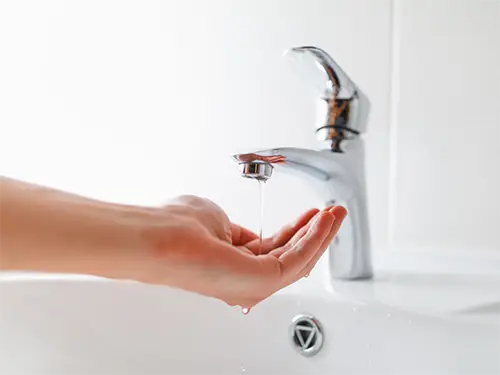 The average household water pressure typically ranges from 40 to 60 PSI, providing enough force to meet your needs. When the pressure drops, it often signals an issue within your plumbing system.
The average household water pressure typically ranges from 40 to 60 PSI, providing enough force to meet your needs. When the pressure drops, it often signals an issue within your plumbing system.
In this article, we’ll explore common causes of low water pressure in your home and provide actionable solutions to restore proper flow.
Your Water Supplier Is Having Issues
Sometimes, the root cause of low water pressure lies outside your home. If your neighbors are also experiencing low water pressure, the issue may be with your water supplier.
Problems like broken water mains, system maintenance, or increased demand can all affect pressure. Contact your water company to report the issue and get updates. If it’s a widespread problem, consider collaborating with your community to push for quicker resolutions.
Regulation Changes in Your City
Municipal regulations can occasionally lower water pressure to conserve resources or improve distribution. If the low pressure is consistent throughout your home and persists over time, check if there have been recent changes in water pressure standards.
Installing a water pressure booster system can help. Hire a licensed plumber to ensure proper installation and compliance with local codes.
Water Meter Valve Isn’t Open All the Way
The water meter valve regulates the water entering your home from the supply line. If this valve isn’t fully open, your water pressure may suffer. This often occurs after plumbing work or utility maintenance.
Reach out to your water company to confirm whether the valve is fully open. Adjustments are best handled by professionals to avoid damaging the valve.
Main House Shutoff Valve Isn’t Open All the Way
A partially closed main shutoff valve restricts water flow and can cause a sudden pressure drop, often limited to specific areas of your home. Check the valve near your water main.
For lever-style valves, ensure they’re parallel to the pipe; for gate valves, turn the handle counterclockwise until it stops. Fully opening the valve should resolve the issue.
Pressure Regulator Is Failing
The pressure regulator ensures consistent water pressure throughout your home. When it fails, you might experience low pressure everywhere. Use a pressure gauge to test the regulator’s output.
If the reading is below 40 PSI, it’s time to replace the regulator. A plumber can assist with testing and replacement to avoid improper installation.
You’ve Got a Leak
Leaks in your plumbing system divert water and reduce pressure. Common signs include pooling water, damp spots, or unexplained pressure loss. For a temporary fix, use a rubber patch and clamp to seal visible leaks.
However, permanent repairs require a plumber’s expertise. Detecting hidden leaks may involve advanced tools like video inspection technology.
Faulty Fixtures
If low pressure affects only certain fixtures, clogged aerators or rust buildup could be the issue. Unscrew the aerator and clean it with vinegar or replace it if damaged.
Always turn off the water supply before removing fixtures to avoid a mess. For more extensive fixture problems, replacement may be the best option.
Clogged Pipes
Over time, debris, mineral deposits, or even tree roots can clog your pipes, restricting water flow. DIY solutions like chemical cleaners can damage pipes or contaminate water, so it’s best to call a plumber for professional pipe cleaning or clearing. A thorough inspection can pinpoint the blockage and ensure proper remediation.
Corroding Pipes
Older homes often suffer from corroded pipes, which can severely impact water pressure. Corrosion is especially common in pipes made of outdated materials like galvanized steel.
If you suspect corrosion, inspect your pipes’ condition and age. Replacement is the most effective solution, though pipe relining can be a cost-effective alternative.
Shared Pipelines
In neighborhoods with shared supply lines, high water usage among neighbors can lead to noticeable pressure drops. If you frequently experience low pressure during peak times, adjust your water usage schedule. In extreme cases, upgrading your pipes to a dedicated supply line might be necessary to ensure consistent pressure.
Too Many People Using Water at Once
Large households or shared living spaces often experience pressure drops when multiple taps are in use. Coordinate water usage to minimize conflicts, such as staggering shower times. For more significant solutions, consult a plumber about system upgrades to handle higher demand.
How to Increase Water Pressure
Restoring proper water pressure starts with identifying the root cause. Plumbers can use video inspection technology to pinpoint problem areas. Depending on the issue, solutions may include pipe cleaning, replacement, or relining. Addressing the problem promptly prevents further damage and ensures your plumbing system operates efficiently.
Having Water Pressure Issues?
 If you’re experiencing low water pressure in your home, Service Minds Benjamin Franklin Plumbing can help. Our punctual plumbers specialize in diagnosing and repairing low water pressure issues, from faulty fixtures to corroded pipes.
If you’re experiencing low water pressure in your home, Service Minds Benjamin Franklin Plumbing can help. Our punctual plumbers specialize in diagnosing and repairing low water pressure issues, from faulty fixtures to corroded pipes.
We serve Niceville, FL, and nearby areas. We dedicate ourselves to restoring your water pressure and keeping your plumbing system running well.
Final Thoughts
Low water pressure can interrupt your daily routine. The solution usually involves finding and fixing the main causes. From minor adjustments to professional repairs, there are plenty of options to restore proper pressure.
For expert assistance, contact Benjamin Franklin Plumbing. With years of experience and a dedication to quality service, we’ll help you resolve your water pressure problems and keep your plumbing system in top shape.
